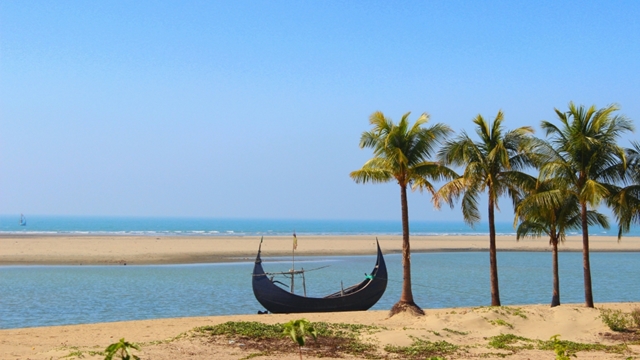Despite having huge potentials to emerge as green beach town, Cox’s Bazar is gradually turning into a polluted place for its unplanned growth, poor waste management and sewerage system.
Hundreds of concrete buildings, including residential hotels, multipurpose buildings and studio apartments, have been developed in the town defying environmental laws.
It has turned into a town of ‘brick and concrete’ without having any wide road, drain and modern sewerage system.
As there is no adequate trash bin, people toss litters everywhere, making the town unclean and unlivable.

Discarded plastic bags, papers, cigarette butts, fruit and vegetable skins and other things are thrown indiscriminately. The handful of trash bins the town now has are not cleaned regularly.
“This has become a serious problem for the people living in Cox’s Bazar,” said Mansur Alam, a resident of Kolatoli area of the town.
He said, “As garbage is dumped here and there and sewerage flows out on roads, bad odur constantly spreads in the air. The huge presence of tourists and poor sewerage system make the tiny town dirty and unhealthy.”
Cox’s Bazar municipality mayor Mujibur Rahman said encroachers grabbed many water bodies and canals in the town, shrinking those and hampering the drainage system.
He said the district administration and the municipality authority have prepared a list of 129 canal grabbers and a drive will be conducted soon to evict them.
Recently, the Department of Environment (DoE) served a notice on 300 residential hotels to install sewerage treatment plants (STPs) but only seven hotels complied with the DoE order.
Last year, the DoE fined Tk five lakh to ‘Nirshorgo Hotel’ while Tk 2 lakh to M/s Imagine hotel at Kalatoli for not having STPs. But no other steps were taken since then.

Visiting different areas of the town, the UNB correspondent found garbage dumped in the beach area and then burnt, which creates black smoke and pollutes the environment.
Besides, over 1,000 establishments have been built on the beach adjacent to Najirartek, Samity para, Borchara and Reju khal areas.
Assistant director of DOE Kamrul Hasan said environment in the town and the beach area is getting polluted in different ways every day.
“Necessary steps will be taken after identifying the causes of pollution and those responsible for it,” he said.
Saiful Asrab, an assistant director at Cox’s Bazar DoE, said a number of high-rise buildings have been built without taking any clearance from the DoE and following other legal procedures.
Seven hotels have installed STPs while eight others sought three months’ time to install STPs, he said, adding that legal action will be taken against the authorities concerned if they fail to set up STPs.
Moazzem Hossain, chairman of Save the Nature, said the environment of the tourist town is being polluted for not setting up STPs by the hotel authorities. If the authorities concerned do not take effective measures immediately then Cox’s Bazar will turn into a city of bad odour, he said.
Azmal Huda, general secretary of Cox’s Bazar Forest and Environment Preservation Council, said the town become unsuitable for living in near future due to the environmental pollution and unplanned construction of high-rises.
Besides, Cox’s Bazar which has been hosting over 1 million Rohingyas since August 25, 2017 is facing serious environmental risk as their presence has made a significant impact on its environment.
Since the influx in August 2017, coupled with the host community and Rohingyas from past influxes, the crisis-hit population is now almost 1.5 million in Cox’s Bazar, creating a massive pressure on the already dilapidated environment there which still remains significantly underfunded, according a United Nations report.
Some 4300 acres of hills and forests were cut down to make temporary shelters for Rohingyas and ensure facilities and cooking fuel for them in Ukhia and Teknaf of Cox’s Bazar, threatening the biodiversity of the ecologically critical areas of the country, said the UN report in September last year.
The United Nations Development Programme (UNDP) and UN Women with support from the Ministry of Environment, Forests and Climate Change jointly carried out the study titled ‘Environmental Impact of Rohingya Influx.
The report highlighted the critical impacts of one of the world’s biggest influx of above 700,000 Rohingyas on the environment of Cox’s Bazar and recommended measures for migration, restoration and conversation.
Of the total 1502 hectares of forests, about 793 hectares have been encroached, says the report.
Around 3000-4000 acres (1200-1600 ha) of hilly land in Teknaf-Ukhia Himchari watershed area have been cleared of vegetation.

Identifying the encroachment as the key cause, the report says nearly 6,800 tonnes of fuel wood are collected each month and each of the Rohingya families use on average 60 culms of bamboo to construct their temporary residences at the top and slopes of hills.
Due to the indiscriminate hill cutting to provide shelters to the Rohingyas, the terrain of the hills has lost their natural setting, causing a potential risk of landslides.
According to information provided at a programme arranged by UNDP in October last, this huge population generates some 10,000 tonnes of waste a month causing adverse impacts on health and environment.


